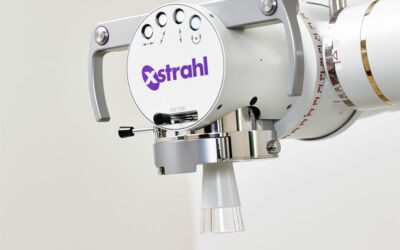Radiotherapy (RT) has been used for the treatment of skin cancers since very early after the discovery of X-rays. Indications for radiotherapy in non-melanoma cancers are controversial, and are usually decided according to the tumor type and the possibility of curing...
Area of Interest
Stereotactic breast irradiation with kilovoltage x-ray beams
The purpose of this work is to determine, using Monte Carlo simulation and a realistic patient model, the characteristics of the resultant absorbed dose distributions when breast tumors are irradiated using small-field stereotactic body radiation therapy (SBRT) with...
Quantitative correlational study of microbubble-enhanced ultrasound imaging and magnetic resonance imaging of glioma and early response to radiotherapy in a rat model
PURPOSE: Radiotherapy remains a major treatment method for malignant tumors. Magnetic resonance imaging (MRI) is the standard modality for assessing glioma treatment response in the clinic. Compared to MRI, ultrasound imaging is low-cost and portable and can be used...
Bioluminescence Tomography-Guided Radiation Therapy for Preclinical Research
PURPOSE: In preclinical radiation research, it is challenging to localize soft tissue targets based on cone beam computed tomography (CBCT) guidance. As a more effective method to localize soft tissue targets, we developed an online bioluminescence tomography (BLT)...
Novel treatment options for nonmelanoma skin cancer: focus on electronic brachytherapy
Nonmelanoma skin cancer (NMSC) is an increasing health care issue in the United States, significantly affecting quality of life and impacting health care costs. Radiotherapy has a long history in the treatment of NMSC. Shortly after the discovery of X-rays and...
Proposal for a Simple and Efficient Monthly Quality Management Program Assessing the Consistency of Robotic Image-Guided Small Animal Radiation Systems
Modern pre-clinical radiation therapy (RT) research requires high precision and accurate dosimetry to facilitate the translation of research findings into clinical practice. Several systems are available that provide precise delivery and on-board imaging capabilities,...
microRNA-34a promotes DNA damage and mitotic catastrophe.
Efficient and error-free DNA repair is critical for safeguarding genome integrity, yet it is also linked to radio- and chemoresistance of malignant tumors. miR-34a, a potent tumor suppressor, influences a large set of p53-regulated genes and contributes to p53-mediated apoptosis. However, the effects of miR-34a on the processes of DNA damage and repair are not entirely understood. We explored tet-inducible miR-34a-expressing human p53 wild-type and R273H p53 mutant GBM cell lines, and found that miR-34a influences the broad spectrum of 53BP1-mediated DNA damage response. It escalates both post-irradiation and endogenous DNA damage, abrogates radiation-induced G 2/M arrest and drastically increases the number of irradiated cells undergoing mitotic catastrophe. Furthermore, miR-34a downregulates 53BP1 and inhibits its recruitment to the sites of DNA double-strand breaks. We conclude that whereas miR-34a counteracts DNA repair, it also contributes to the p53-independent elimination of distressed cells, thus preventing the rise of genomic instability in tumor cell populations. These properties of miR-34a can potentially be exploited for DNA damage-effecting therapies of malignancies.
Kofman AV, Kim J, Park SY, Dupart E, Letson C, Bao Y, Ding K, Chen Q, Schiff D, Larner J, Abounader R.
Download Paper
Radiotherapy for benign disease; assessing the risk of radiation-induced cancer following exposure to intermediate dose radiation
Most radiotherapy (RT) involves the use of high doses (>50 Gy) to treat malignant disease. However, low to intermediate doses (approximately 3–50 Gy) can provide effective control of a number of benign conditions, ranging from inflammatory/proliferative disorders...
Systemic Tolerance Mediated by Melanoma Brain Tumors Is Reversible by Radiotherapy and Vaccination
PURPOSE: Immune responses to antigens originating in the central nervous system (CNS) are generally attenuated, as collateral damage can have devastating consequences. The significance of this finding for the efficacy of tumor-targeted immunotherapies is largely...
Contact Us



